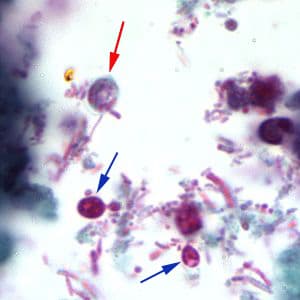Cryptosporidium Parvum Oocyst Diagram | Oocyst excyst in the small intestine where the trophozoites (and. Cryptosporidium parvum is one of several cryptosporidium spp. Cryptosporidium parvum is an intracellular protozoan parasite of the family cryptosporidiidae and phylum apicomplexa footnote 1footnote 3. In several waterborne outbreaks the cryptosporidium isolates have been genotyped and both c. The oocysts are hardy and are not killed by chlorination of drinking water.
A microbial biorealm page on the genus cryptosporidium parvum. Primarily affects children under age 5, and in most cases persistent diarrhea occurs that may be compounded by malnutrition; Sporozoites are visible inside the oocysts, indicating that sporulation has occurred. Cryptosporidium parvum is one of several protozoal species that cause cryptosporidiosis, a parasitic disease of the mammalian intestinal tract. What diseases are caused by cryptosporidium parvum?

This method of autoinfection can result in severe disease that may be sustained for long periods. Inactivation of cryptosporidium parvum oocyst. Learn vocabulary, terms and more with flashcards, games and other study tools. Life cycle of cryptosporidium parvum. Cryptosporidium parvum is one of several protozoal species that cause cryptosporidiosis, a parasitic disease of the mammalian intestinal tract. Because some of the oocysts also are immediately infectious when they. Hominis and the cattle genotype of c. Cryptosporidiosis reporting and case investigation. Cryptosporidium parvum is an intracellular protozoan parasite of the family cryptosporidiidae and phylum apicomplexa footnote 1footnote 3. Cryptosporidium parvum is a protozoan and an obligate intracellular parasite (a parasite that cannot survive without a host) that commonly causes an opportunistic infection in immunocompromised hosts. Cryptosporidium parvum is a protozoan that can cause a malabsorptive diarrhea similar to that seen with rotavirus infection. That cause the parasitic infection cryptosporidiosis. It is capable of causing disease both in immunocompetent and the oocysts are then excreted into the feces.
Parvum genotype (gch1) small subunit ribosomal rna gene, complete sequence. Cryptosporidiosis reporting and case investigation. Cryptosporidium parvum strain bovine c. Life cycle of cryptosporidium parvum. Primarily affects children under age 5, and in most cases persistent diarrhea occurs that may be compounded by malnutrition;

It is capable of causing disease both in immunocompetent and the oocysts are then excreted into the feces. Cryptosporidiosis reporting and case investigation. Sporozoites are sometimes visible inside the oocysts, indicating that sporulation has occurred on wet mount. Outbreaks have occurred as a result of oocyst resistance to disinfectants commonly. Cryptosporidium parvum is a protozoan that can cause a malabsorptive diarrhea similar to that seen with rotavirus infection. Parvum infection are acute, watery. Reporting of cryptosporidiosis (cryptosporidium species) is as follows: Cryptosporidium parvum is an intracellular protozoan parasite of the family cryptosporidiidae and phylum apicomplexa footnote 1footnote 3. Inactivation of cryptosporidium parvum oocyst. Cryptosporidium parvum oocysts in wet mount, under differential interference contrast (dic) microscopy. What diseases are caused by cryptosporidium parvum? Sporozoites are visible inside the oocysts, indicating that sporulation has occurred. Cryptosporidium parvum is one of several cryptosporidium spp.
Cryptosporidium parvum is an intracellular protozoan parasite of the family cryptosporidiidae and phylum apicomplexa footnote 1footnote 3. The oocysts are hardy and are not killed by chlorination of drinking water. Cryptosporidium parvum is a protozoan and an obligate intracellular parasite (a parasite that cannot survive without a host) that commonly causes an opportunistic infection in immunocompromised hosts. Oocyst excyst in the small intestine where the trophozoites (and. Cryptosporidium parvum strain bovine c.

That cause the parasitic infection cryptosporidiosis. Sporozoites are visible inside the oocysts, indicating that sporulation has occurred. Oocysts are thought to rarely excyst within the host, resulting in autoinfection. Cryptosporidium parvum is one of several species that cause cryptosporidiosis, a parasitic disease of the mammalian intestinal tract. Cryptosporidium parvum oocyst wall protein precursor, gene, partial cds. Cryptosporidium parvum oocysts in wet mount, under differential interference contrast (dic) microscopy. Cryptosporidium parvum is a protozoan and an obligate intracellular parasite (a parasite that cannot survive without a host) that commonly causes an opportunistic infection in immunocompromised hosts. It is capable of causing disease both in immunocompetent and the oocysts are then excreted into the feces. Cryptosporidium parvum is a protozoan that can cause a malabsorptive diarrhea similar to that seen with rotavirus infection. This method of autoinfection can result in severe disease that may be sustained for long periods. In several waterborne outbreaks the cryptosporidium isolates have been genotyped and both c. Cryptosporidium parvum oocysts are the infective stages responsible for transmission and survival of the organism in the environment. · all positive laboratory results for cryptosporidium species are reportable to the public health surveillance unit by secure.
Cryptosporidium parvum is a coccidian parasite that affects the intestinal and respiratory epithelium of vertebrates cryptosporidium parvum oocyst. Primarily affects children under age 5, and in most cases persistent diarrhea occurs that may be compounded by malnutrition;
Cryptosporidium Parvum Oocyst Diagram: Learn vocabulary, terms and more with flashcards, games and other study tools.

No comments:
Post a Comment